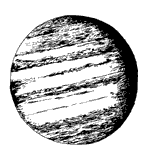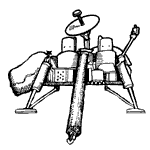|
Science fiction provides many fine literary connections and extensions
for this GEMS guide. The play by Brecht gives students dramatic
insight into Galileo’s life, and even contains information
on his observations—the same observations the students make
via slides in the classroom. Other books about Galileo or about
telescopic observation also make good connections.
Several of the books involve exploring and colonizing other planets.
In The Planets there is a highly sophisticated science
fiction story about colonization of one of Jupiter’s moons.
Look for any good stories about exploration and settlement of
the Earth’s Moon, or other planets/galaxies. Ethical issues
are often involved, including: nationalistic competition on Earth
in the “race for space,” imagined diplomatic and/or
antagonistic relations with extraterrestrials, and whether or
not to colonize or exploit natural resources found in space.
Venus, Mars, and Jupiter, because of their prominence in the nighttime
sky, have inspired a large number of folktales, legends, and myths.
Their rising and setting times are often important agricultural
markers. Books such as Star Tales: North American Indian Stories
or They Dance in the Sky are but two examples from many
that provide great opportunities for literary connections and
increased cultural understandings.
2010: Odyssey Two
Against Infinity
Einstein Anderson Makes Up for Lost
Time
The Faces of Ceti
Galileo
Jupiter Project
The Jupiter Theft
Life of Galileo
The Planets
Star Tales: North American Indian Stories
The Three Astronauts
They Dance in the Sky: Native American Star
Myths
2010: Odyssey Two
by Arthur C. Clarke
Ballantine Books, New York. 1982
Grades: 10–Adult
This complex, mysterious, and thought-provoking sequel to
Clarke’s 2001: A Space Odyssey had the benefit of
being written subsequent to the Voyager mission. Chapter 13 specifically,
“The Worlds of Galileo,” focuses on the four main moons
of Jupiter, although there are fascinating observations, accurate
scientific information, and lots of interesting speculation about
Jupiter and its moons throughout the book, not to mention spirits
of intergalactic intelligence and Jupiter becoming a second sun.
More advanced students may want to evaluate the accuracy of Clarke’s
descriptions of Io, Europa, Ganymede, and Callisto.
Return to titles list.
Against Infinity
by Gregory Benford
Simon & Schuster, New York. 1983
Grades: 10–Adult
This science fiction novel is an account of human settlement
on Jupiter’s largest moon, Ganymede. The story takes place
several hundred years into the colonization process, and begins
from the perspective of a 13-year-old boy whose father is one
of the leaders of the settlement. The novel ties in well with
the final session in which student teams undertake scientific
missions to devise and build moon settlements on one of Jupiter’s
moons. Advanced students may want to read this novel to gather
ideas about constructing biospheres, melting ice, obtaining minerals,
and other ways humans might possibly survive on the moons of Jupiter.
(The author is a Professor of Physics at the University of California,
Irvine.)
Return to titles list.
Einstein Anderson Makes Up for Lost
Time
by Seymour Simon; illustrated by Fred Winkowski
Viking Penguin, New York. 1981
Grades: 4–7
Chapter 6 poses the question “How can Einstein tell a
planet from a star without using a telescope?” He explains
to his friend Dennis that although stars twinkle, planets usually
shine with a steady light. Looking through the telescope, he thinks
the steady light he sees is Jupiter. The four faint points of
steady light nearby are Jupiter’s moons.
Return to titles list.
The Faces of Ceti
by Mary Caraker
Houghton Mifflin, Boston. 1991
Grades: 6–12
In this science fiction thriller, colonists from Earth form
two settlements on adjoining planets of the Tau Ceti system. One
colony tries to survive by dominating the natural forces that
they encounter, while those who land on the planet Ceti apply
sound ecological principles and strive to live harmoniously in
their new environment. Nonetheless, the Cetians encounter a terrible
dilemma—the only edible food on the planet appears to be
a species of native animals called the Hlur. Two teen-age colonists
risk their lives in a desperate effort to save their fellow colonists
from starvation without killing the gentle Hlur.
Return to titles list.
Galileo
by Leonard Everett Fisher
Macmillan Publishing, New York. 1992
Grades: 3–7
This nonfiction work provides a carefully written and well-illustrated
account of Galileo’s life and accomplishments. His observations
of Jupiter’s moons are placed in the context of a life of
remarkable discoveries in many fields. The book handles the conflict
with the Catholic Church in an interesting and balanced way, including
modern Papal statements in a brief “More About Galileo”
section at the end of the book. An excellent way to provide students
with a concise assessment of Galileo’s many accomplishments,
triumphs, and tragedies.
Return to titles list.
Jupiter Project
by Gregory Benford
Bantam Books, New York. 1990
Grades: 7–10
A teen-ager lives with his family as part of a large scientific
laboratory that orbits Jupiter, but he is ordered to return home.
He has one chance to stay; if he can make an important discovery.
There is a nice mix of physics and astronomy with teen-age rebellion
and growing maturity, some love interest, and an exciting plot.
The descriptions in Chapters 6, 7, and 8, which are part of an
account of an expedition to Ganymede, could be compared by students
to the information they observe and learn about this mammoth moon.
Return to titles list.
The Jupiter Theft
by Donald Moffitt
Ballantine Books, New York. 1977
Grades: 7–Adult
Strange, advanced beings from somewhere near the constellation
of Cygnus encounter a Jupiter expedition from Earth. The Cygnans
want to take Jupiter away to use as a power source as they migrate
through the universe. There is some graphic violence as various
life forms attack and/or ally with each other, but in general
the focus is on scientific speculation. In addition to interesting
descriptions of Jupiter and its moons, the book has a wealth of
cogent speculation on the possibilities and varieties of life
on other worlds.
Return to titles list.
Life of Galileo
by Bertolt Brecht
Grove Weidenfeld, New York. 1966
Grades: 9–12
This play is a rich literary extension to this unit. During the
early scenes of the play, there are several references to, explanations
of, and controversies about the telescope, Galileo’s observations
of the Earth’s moon, and the implications of his tracking
of Jupiter’s moons—the exact activity that the students
recreate during the first activity. Much of the rest of the play
focuses on science and society, church policies of the time, and
other incisive social criticism characteristic of Brecht. Dramatizing
several of the early scenes would make a great extension, and
Galileo’s long speech near the end of the play raises relevant
issues. (The play is also available in the collection Brecht:
Collected Plays, Vintage Books, Random House, 1972.)
Return to titles list.
The Planets
edited by Byron Preiss
Bantam Books, New York. 1985
Grades: 8–Adult
This extremely rich, high-quality anthology pairs a nonfiction
essay with a fictional work about the earth, moon, each of the
planets, and asteroids and comets. Introductory essays are by
Issac Asimov, Arthur C. Clarke and others. The material is dazzlingly
illustrated with color photographs from the archives of NASA and
the Jet Propulsion Laboratory, and paintings by astronomical artists
such as the movie production designers of 2001 and Star Wars.
“The Future of the Jovian System” by Gregory Benford
(about colonization and development of Jupiter’s moon Ganymede)
is a perfect match to the final activity. The vocabulary is sophisticated,
so it may be more suitable for higher-level readers.
Return to titles list.
Star Tales: North American Indian Stories
retold and illustrated by Gretchen W. Mayo
Walker & Co., New York. 1987
Grades: 5–12
The nine legends in this collection explain observations of
the stars, moon, and night sky. Accompanying each tale is information
about the constellation or other heavenly observation and how
various peoples perceived and interpreted it. Stories like these
from Native American and other world cultures can be interwoven
with astronomy activities.
Return to titles list.
The Three Astronauts
by Umberto Eco; illustrated by Eugenio Carmi
Harcourt, Brace, Jovanovich, San Diego. 1989
Grades: K–5
An American, a Russian, and a Chinese astronaut take off separately
in their own rockets with the goal of being first on Mars. They
all land at the same time, immediately distrusting each other.
When they encounter a Martian, their cultural differences disappear
as they unite against him. In a surprise happy ending, they recognize
the humanity of the Martian after observing his charity toward
a baby bird and extend this understanding to differences between
all peoples. Younger children may not get the full benefit of
the sophisticated illustrations and humor. The astronauts are
all male, with no female characters or references.
Return to titles list.
They Dance in the Sky: Native American
Star Myths
by Jean Guard Monroe and Ray A. Williamson
Houghton Mifflin, Boston. 1987
Grades: 5–12
Stories from many Native American regions and peoples, including
the Southwest and Southeast, the Plains Indians, the Pawnee, the
Northwest Coast, and California Indians are particularly suitable
for reading aloud. Stories about the Pleiades, the Big Dipper,
and the “Star Beings” are noteworthy, but all are imaginative
and intriguing. Stories like these from Native American and other
world cultures can be interwoven with astronomy activities, provide
a sense of careful observation over time, and highlight how the
stars and planets have always inspired the human imagination.
Return to titles list.
|
|


